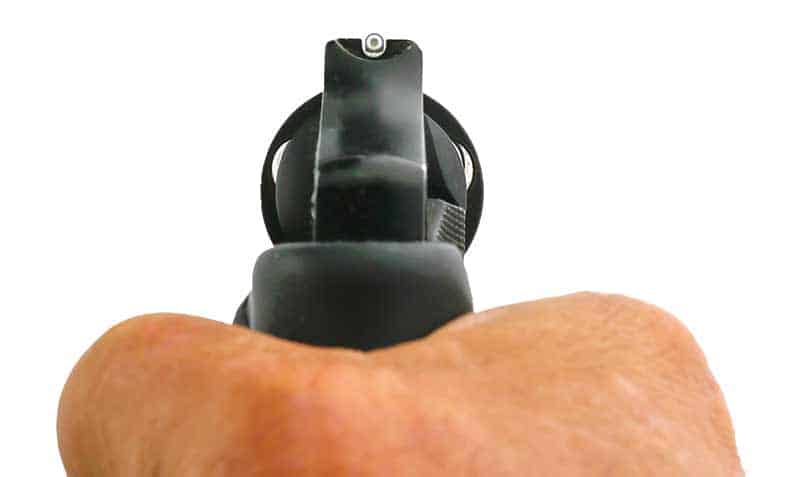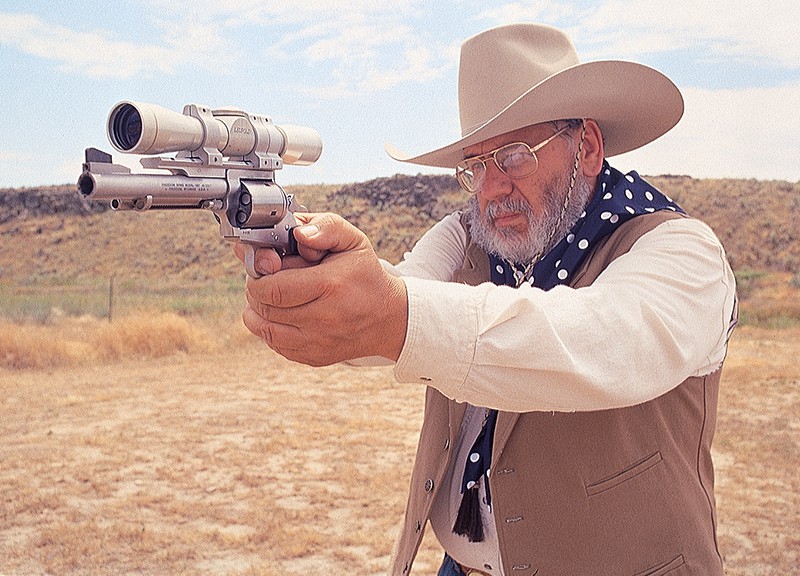One Particular M&P
You might think ‘semi’ but you’d be wrong
The “Military & Police” has been a Smith & Wesson trademark since 1899 and over the decades I’ve accumulated several, going back to the first iteration. My M&P revolvers include .38 Special, of course, but also .357 Magnum, a couple of Model 58 .41 Mags, and even a pair of the uber-rare Coast Guard 6″ fixed-sight .22s. Been a while since I carried one, though.
Like other S&W collectors, I had mixed feelings when S&W put the M&P sobriquet on their polymer pistols almost 20 years ago but the guns themselves are pretty cool: Mine range from .22 LR to a long-slide 9mm to a very sweet M&P Compact in .357 SIG. I admit, though, I don’t use them as much as I used to.
The Shield comes under the M&P umbrella and these M&Ps sold the most in the shortest time. In the August 2021 issue of GUNS’ sister publication Shooting Industry, editor Jade Moldae noted, “Smith & Wesson was the top maker of 9mm-chambered pistols in the 2010s, with 3,976,014 produced. It was the lead 9mm producer for five consecutive years (2013-2017), peaking at 823,260 pistols in 2016, a record mark (and more pistols than the entirety of 2005). The M&P Shield was a primary driver during this period, taking just three years to reach the 1 million production plateau after its 2012 debut.” I understand why they’re so popular. I own them in all three calibers: 9mm, .40 S&W and my favorite .45 ACP that brought me to the prize table at the Pin Shoot’s Concealed Carry event. But they aren’t my most-carried M&Ps, either.
And the Winner Is …
The M&P I spend most time with by far is my preferred backup gun, the 340 M&P. Chambered for .357 Magnum. Mine is generally loaded with Speer 135-grain .38 Spl +P Gold Dot, the bonded, jacketed hollow point designed by Ernest Durham and his team expressly for maximum performance in 2″ barrel revolvers — a long-since “street-proven” load giving excellent rapid fire control in trained hands.
This J-Frame five-shooter is a metallurgical vichyssoise of steel, aluminum and Scandium. It’s about the weight of the less-expensive aluminum-framed Airweight Model 442 .38, but the Scandium makes it strong enough for .357 Magnum. All of this is good — but what sold me on the 340 M&P when I first shot one when it was introduced at an industry show in 2005 was the sights. Upfront, there’s the Big Dot Tritium Express sight you just can’t miss while behind it is a huge U-notch. This allows you to center the big front sight precisely enough for a guaranteed head shot at 25 yards.
Let me clarify one thing — the gun and the Gold Dot guarantee it, but the rest is up to us shooters!
Tailored To The Task
Why was this feature set so important for a backup gun? From a pocket, a “hammerless” revolver draws just a little bit faster than a square-back compact autoloader. Another thing: When even professionals are relaxed and off-duty, they are concerned their significant other might be able to use their gun in self-defense if the occasion arose and they themselves were incapacitated. The double-action-only revolver is simply easier for anyone to “make go bang” and not worry about a crossed-over support hand thumb blocking the slide and jamming the gun, or a limp-wristed hold causing the same problem. One reason for carrying a second “backup gun” is to allow some other good guy or gal to be armed in a life-threatening emergency. When this happens, there won’t be time to give the other person a tutorial on “here’s the safety, here’s the decock lever, and by the way don’t let your support hand thumb get behind the slide.” A “hammerless” revolver eliminates all those issues.
My wife ain’t gonna cross her thumb behind the slide on an auto: She’s a state and regional champion shooter who generally carries a gun of her own. But I’ve been in situations with guys I knew were competent but had gained their competence with guns other than mine, and if it happened again I didn’t want to worry about crossed-over thumbs and such. Actually, like Jerry Miculek, I personally do cross the support hand thumb over the back of the firing hand to get it out of the way on a little J-Frame.
Now, I’ll grant the J-Frame doesn’t have the cartridge capacity of the M&P Shield Plus 9mm I just bought. The Shield Plus carries 11+1 with its short magazine — the payload of a J-Frame and a six-shot K-Frame M&P revolver — and you get 13+1 with the extended mag. But I’m faster clearing the hammerless J-Frame than I am with any auto due to the shape of the guns and I’d rather have five shots in hand now than 11 or 14 a few seconds from now. Your needs may vary.
There was a time when it was more important to me to have a backup that fed the same ammo as my duty gun. As a young patrolman, there were two years when I had to carry a K-Frame S&W, so my backup was a D-Frame snub-nose Colt which would take the same HKS speedloaders as the service revolver. During the couple of years I wore a GLOCK 22 as a duty pistol, the backup on my ankle was a GLOCK 27 that would feed the G22’s .40 S&W mags. In either case, if my duty gun was out of my control, I had another gun and two reloads to fight with. Today, as a geezer retired from police work, a spare Bianchi Speed Strip in the cargo pocket is there to feed my 340 M&P. As the late, great Pat Rogers used to say, “The mission drives the gear train.”









